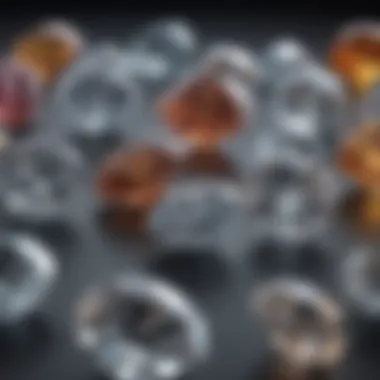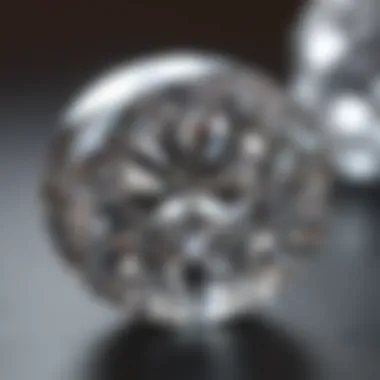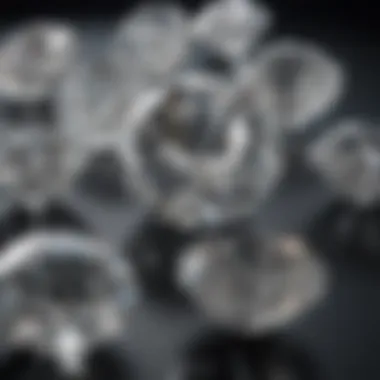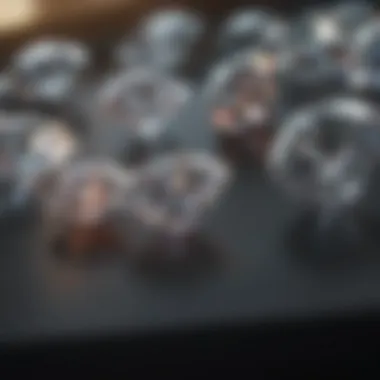Understanding Diamond Cut and Clarity for Value


Intro
Diamonds have long fascinated humanity with their brilliance and rarity. The allure of a diamond often lies not just in its physical attributes, but in the factors that define its overall appeal. Two critical aspects are cut and clarity, which dramatically influence how a diamond is perceived. Understanding these elements is essential for both enthusiasts and collectors alike.
As we delve into the world of diamonds, we will explore how the cut of a diamond impacts its ability to reflect light and capture the eye. We will also examine clarity, which relates to the presence of internal or external imperfections known as inclusions. Both of these characteristics play pivotal roles in determining a diamond’s aesthetic and economic value.
Navigating through the intricacies of these factors can be daunting. However, this article aims to simplify the complexities of diamond cut and clarity, providing valuable insights for making informed gemstone choices.
Gemstone Overview
Definition and Characteristics
Diamonds are a specific form of carbon that crystallize under extreme pressure and temperature within the Earth’s mantle. Their physical properties include exceptional hardness, rating a 10 on the Mohs scale. This hardness is what makes diamonds ideal for both industrial applications and as exquisite gemstones.
Classification of Gemstones
Gemstones are broadly classified based on their chemical composition and physical properties, including transparency, luster, color, and clarity. Diamonds fall into the category of precious gemstones due to their rarity and the qualities that make them desirable in jewelry. Other classifications also account for factors such as the treatment process applied to enhance certain features.
Properties of Gemstones
Physical Properties
Physical properties of diamonds include:
- Brilliance: The ability to reflect white light.
- Fire: The dispersion of light into different colors.
- Saturation: The richness of a diamond's color.
These properties influence the overall perception of beauty in diamonds. The cut specifically affects these qualities to a large extent.
Chemical Properties
Chemically, diamonds are composed entirely of carbon atoms arranged in a crystal lattice structure. This unique arrangement leads to their exceptional hardness and ability to withstand wear. Understanding these chemical properties helps in recognizing how diamonds differ from other gemstones, which might exhibit varied elemental compositions.
"The beauty of a diamond is not just skin deep; it is also rooted in its complex structural and chemical makeup."
As we explore cut and clarity further, it becomes evident how intricately linked these properties are to the overall value and desirability of a diamond.
Prelims to Diamond Attributes
The allure of diamonds often captivates collectors and jewelry enthusiasts alike. Understanding the attributes of diamonds is essential for making informed decisions when purchasing these precious gemstones. This section delves into the importance of diamond cut and clarity, which play significant roles in determining a diamond's aesthetic appeal and its overall value in the market. By examining these attributes in detail, we can distinguish quality diamonds from the rest.
The Importance of Cut and Clarity
Cut and clarity are among the most crucial factors influencing a diamond's beauty and value. Cut refers to how well the diamond has been shaped and faceted, affecting its brilliance and how it interacts with light. An exceptionally cut diamond captures and reflects light more effectively, creating an engaging visual experience. Consequently, the right cut can elevate the attractiveness of a diamond significantly.
Clarity, on the other hand, describes the presence of internal or external imperfections known as inclusions and blemishes. Higher clarity grades usually correlate with a clearer, more desirable stone. The absence of flaws enhances the diamond's appeal and value. In the jewelry industry, consumers are often willing to pay a premium for diamonds with superior clarity, underscoring its importance.
Both cut and clarity jointly contribute to a diamond's overall magnificence. Understanding this relationship is vital for potential buyers, enabling them to prioritize what truly matters when selecting a gem.
Overview of the Four Cs
To comprehend diamonds better, one must consider the Four Cs: Cut, Clarity, Carat weight, and Color. Each of these attributes interplays to determine a diamond's overall quality and price.
- Cut: The precision with which a diamond is shaped. A well-executed cut maximizes its brilliance and visual impact.
- Clarity: This addresses the presence and nature of imperfections. Higher clarity usually equals stronger desirability.
- Carat Weight: This indicates the size of the diamond. Larger diamonds typically have a higher price.
- Color: Refers to the hue of the diamond, with completely colorless stones generally being more sought after.
In summary, understanding the Four Cs provides a framework for evaluating diamonds. Knowledge of these attributes will guide consumers and collectors toward making informed decisions, ensuring they choose diamonds that truly capture their interest and meet their standards.
The Concept of Cut
The concept of cut is essential in the analysis of diamonds. It does not simply refer to the shape of the stone, but encompasses the angles, proportions, and facets that impact how a diamond interacts with light. Understanding cut is crucial for anyone in the gemstone industry because it directly influences the diamond's brilliance and overall appearance. The cut can enhance or undermine the natural beauty of the stone, making its evaluation vital for both aesthetic appeal and market value.
Definition of Diamond Cut


A diamond cut includes factors such as the symmetry, polish, and proportions of the diamond. It determines how well light enters, interacts with the stone, and ultimately exits. A well-executed cut can maximize brilliance, while a poorly executed one can leave a diamond looking dull. The standards for cut are generally categorized from excellent to poor, based on their impact on the diamond's performance. This intricate balance plays a key role in the value and desirability of a diamond.
Types of Diamond Cuts
The various types of diamond cuts each offer unique characteristics and appeal. Understanding these cuts can help buyers make informed decisions. Each cut, with its own personality, contributes to the light performance and visual allure of diamonds.
Round Brilliant Cut
The Round Brilliant Cut is the most popular diamond shape. Its design features 58 facets that maximize light reflection, creating incredible brilliance. The key characteristic of this cut lies in its ability to return more light than others. This is why it is often seen as a priceless choice for engagement rings. However, the downside is that high-quality round diamonds can come with a premium price tag.
Princess Cut
The Princess Cut is a contemporary favorite, known for its modern appeal. This cut also boasts numerous facets, giving it excellent brilliance and fire. Its cornered shape stands out, appealing to those who prefer a more angular look. However, the distinctive sharp corners can be prone to chipping, which is a factor to consider when selecting this cut.
Emerald Cut
With its elongated shape and large, flat facets, the Emerald Cut showcases a different type of beauty. It emphasizes clarity over brilliance, making inclusions more visible. The key aspect of the Emerald Cut is its step-cut facetting style, which creates a hall of mirrors effect. This cut is often chosen for its elegance, but buyers should prioritize clarity more than with other cuts.
Cushion Cut
The Cushion Cut is a blend of square and rectangular shapes, offering a romantic vintage style. This cut may have rounded corners and larger facets, contributing to its unique light performance. It is often valued for its softness and warmth. However, the larger facets can also reveal imperfections more easily, which might detract from its overall appeal if clarity is inadequate.
Asscher Cut
Asscher Cut diamonds are characterized by their octagonal shape and deep facets. Similar to the Emerald Cut, it emphasizes clarity, and its unique appearance often attracts vintage jewelry enthusiasts. The deep cut captures light beautifully but may be harder to find and typically comes with a higher cost due to its distinctiveness.
Marquise Cut
The Marquise Cut is elongated, resembling a boat shape, which can create an illusion of greater size. Notably, this cut maximizes carat weight, providing more perceived size per stone. Its unique shape adds drama, but the pointed ends require careful setting to prevent chipping.
Radiant Cut
Combining the best of round and princess cuts, the Radiant Cut features trimmed corners and brilliant facets. It maintains impressive brilliance while providing a unique rectangular or square appearance. However, its complex shape also means that symmetry is crucial, as any imperfections can impact its overall appeal.
Oval Cut
The Oval Cut, with its elongated appearance, offers a flattering reflection of light, similarly to the Round Brilliant Cut. It is favored for its ability to appear larger while also having excellent brilliance. However, buyers should be aware of the potential bowtie effect where darkness may appear in the middle due to light reflection issues, which could lessen its charm.
The Relationship Between Cut and Light Performance
The cut plays a pivotal role in the light performance of diamonds, impacting three key aspects: brilliance, fire, and scintillation. Understanding how these factors interconnect is crucial for anyone looking to select a diamond.
Brilliance
Brilliance refers to the amount of white light that returns to the eye from the diamond. It is a key factor in determining how vivid and eye-catching a diamond appears. A well-cut diamond maximizes its brilliance, making it appear more lively and beautiful. It is an essential element for any diamond lover to consider.
Fire
Fire describes the dispersion of light into colors. A diamond that exhibits strong fire creates a rainbow effect, adding to its allure. Understanding how different cuts affect fire can help buyers choose stones that display this sought-after quality in appropriate lighting conditions.
Scintillation
Scintillation is the sparkle and flash a diamond displays as it moves. A well-cut diamond creates a dance of light and shadow, enhancing its overall effect. Scintillation can vary from cut to cut, making it an important consideration for those who value visual intrigue in their diamonds.
Assessing Diamond Cut Quality
Assessing the quality of a diamond's cut is crucial in determining its overall appearance and value. The cut influences the way light interacts with the stone, which in turn affects its brilliance and visual appeal. A diamond with an excellent cut grade will not only dazzle but also hold its value over time. Understanding this aspect allows buyers to make informed choices based on their preferences and budget. Evaluating cut quality requires attention to detail, knowledge of industry standards, and an understanding of how each grade affects the stone's performance.
Evaluating Cut Grades
Excellent
Excellent cut diamonds are those that achieve optimal proportions and symmetry in their facets. This grade contributes significantly to the diamond's brilliance. The key characteristic of an excellent cut is its ability to reflect and refract light in a way that maximizes sparkle. For buyers aiming for the best visual impact and longevity, selecting an excellent cut is beneficial. The unique feature of this cut is its precision in angles and proportions, which reduces light leakage and enhances overall appearance. The main advantages are high value retention and aesthetic appeal.


Very Good
Diamonds graded as very good have cuts that are close to excellent, but with slight deviations. This category provides a balance between quality and cost. The primary characteristic of very good cuts is their strong light performance, although not as pronounced as in excellent cuts. This makes them a popular choice among those looking for value. These diamonds still shimmer beautifully, but may display some minor light leakage. The advantage of choosing a very good cut is its affordability while still retaining impressive beauty.
Good
A good cut reflects satisfactory proportions and symmetry, but its light performance is not as exceptional. Such diamonds present a decent sparkle, making them suitable for buyers on a tighter budget. The defining feature of a good cut is that it may show minor inclusions or a lack of precision in angles. While the visual impact is less impressive than higher grades, the advantage lies in accessibility and varied price points, appealing to a broader audience.
Fair
Fair cut diamonds have noticeable asymmetry and can display poor light performance. These stones are not ideal if brilliance is a priority. However, they may serve well in specific jewelry settings where sparkle is less critical, such as in intricate designs. The key characteristic here is affordability. Buyers can find larger stones at lower prices, which can be appealing for certain collections. Nonetheless, the disadvantage is that their resale value is typically lower.
Poor
Diamonds with a poor cut grade often lack symmetry and have significant flaws in proportions. These stones do not reflect light effectively and appear dull. While purchasing a poor cut can lead to substantial savings, the major drawback is their low aesthetic appeal and poor performance. This grade is rarely recommended for discerning buyers, as the disadvantages far outweigh any potential financial gain. Poor cuts result in stones that may not hold value over time or enhance the overall design of jewelry.
Impact of Proportions on Cut Quality
Proportions play a central role in determining the quality of a diamond cut. Proper proportions ensure that light enters and exits the stone effectively, maximizing its brilliance. A well-proportioned diamond will have a balance between depth and width, ensuring optimal reflection and refraction.
Factors to consider include:
- Table Size: The flat top of the diamond should be proportionate to the overall size to avoid light leakage.
- Depth Percentage: The depth of the diamond affects its brilliance. A depth that is too shallow or too deep can diminish light return.
- Crown and Pavilion Angles: These angles dictate how light interacts within the diamond. Precise angles enhance sparkle.
Each of these elements contributes to the overall cut quality, and understanding them equips buyers with the knowledge to select a diamond that meets their expectations.
Understanding Clarity
Understanding clarity is essential when evaluating diamonds. Clarity refers to the presence of inclusions and blemishes within or on the surface of the diamond. This aspect significantly affect a stone's appearance and, consequently, its value. Many buyers focus on clarity when searching for the perfect diamond, and this section aims to clarify how one can effectively assess clarity. The characteristics of clarity will be discussed in detail, allowing readers to make informed decisions regarding their diamond purchases.
Definition of Diamond Clarity
Diamond clarity is defined as the measure of internal and external flaws in a diamond. These flaws can be natural inclusions and surface blemishes. A diamond that exhibits fewer blemishes is often deemed more valuable and desirable. The Gemological Institute of America, or GIA, is one organization that provides guidelines on clarity grading, helping potential buyers understand the gem they are purchasing.
Clarity Grading Scale
Diamonds are graded on a clarity scale that includes several categories. Understanding these categories helps potential customers evaluate the appearance and value of a diamond.
Flawless
Flawless diamonds, often marked with the grade "F", show no inclusions or blemishes visible under 10x magnification. This category represents the pinnacle of diamond clarity. The key characteristic of flawless diamonds is their perfect structure, which provides exceptional visual appeal. They are popular choices for high-end jewelry. However, they come with a significant price premium, and finding a perfectly flawless diamond may require considerable searching.
Internally Flawless
Internally Flawless diamonds, graded as "IF", contain no internal inclusions but may have some surface blemishes. This quality makes these diamonds highly desirable. They retain impressive light performance and visual aesthetics. Buyers appreciate these diamonds because they offer a balance between clarity and cost. However, the presence of even minor surface blemish may delay the purchase for some individuals.
Very Very Slightly Included
Diamonds graded as "VVS1" and "VVS2" are labeled Very Very Slightly Included. This category indicates that any inclusions are extremely difficult to detect with 10x magnification. Enthusiasts appreciate these diamonds as they represent a sweet spot between quality and value. The potential for a very clean stone attracts buyers, but some may find they are still not quite perfect enough for their tastes.
Very Slightly Included
Very Slightly Included diamonds, marked as "VS1" or "VS2", contain minor inclusions that are visible under 10x magnification but not to the untrained eye. This clarity grade provides value for buyers who want a beautiful gemstone without the elevated price tag of higher grades. The elements that distinguish these diamonds are often ignored in casual observation, thus offering an attractive blend of affordability and quality.
Slightly Included
Diamonds labeled as "SI1" and "SI2" are considered Slightly Included. These stones contain noticeable inclusions that are visible to a jeweler's loupe or possibly to the naked eye, depending on their placement. While these inclusions can slightly detract from the beauty, many buyers still find these diamonds appealing, especially in more affordable ranges.
Included
Included diamonds, classified as "I1", "I2", and "I3", exhibit significant inclusions that are readily visible to the naked eye. The presence of these flaws typically reduces the diamond's brilliance and overall desirability. Buyers should approach stones with this grade with care, as the investment in such a diamond might not yield the visual appeal they seek in their jewelry purchase.


Common Types of Inclusions and Blemishes
Understanding common types of inclusions and blemishes is crucial when assessing clarity. Each inclusion type has distinct characteristics that can impact the diamond's value and appearance.
Crystal Inclusions
Crystal inclusions are small minerals or rocks trapped within the diamond. They vary in shape and size, often adding uniqueness to the stone. However, buyers should be cautious as their presence can detract from the overall clarity impression.
Clouds
Clouds consist of tiny groups of crystal inclusions that create a hazy appearance. While clouds are sometimes invisible to the naked eye, they can reduce clarity. Buyers should evaluate how these may impact sparkle when choosing a diamond.
Feathers
Feathers are internal inclusions that resemble tiny feathers. Weaker areas caused by feathers can compromise a diamond's structural integrity over time. While they can sometimes be visually masked, it is essential to ask jewellers about their potential effects on durability.
Needles
Needles are slender, elongated inclusions that can look like thin lines. These may not always impact clarity significantly but can affect the way light dances off a diamond. Buyers may want to consider this aspect if they plan to use the diamond in high-stress settings.
Pinpoints
Pinpoints are tiny, reflective inclusions that can sparkle alongside the diamond's natural brilliance. They are often deemed less detrimental than other types of inclusions, but their presence can still lower the gem's clarity grade. Understanding how to interpret pinpoints is vital for assessing clarity accurately.
Surface Blemishes
Surface blemishes refer to imperfections on the exterior of a diamond, such as scratches or chips. These can affect the stone's visual appeal markedly. While they may not influence the clarity grade significantly, buyers should prioritize fully examining the diamond's surface during purchasing.
In summary, clarity is a major factor influencing not only the appeal but also the value of a diamond. By understanding the grading scale and types of inclusions, buyers can make more informed choices, ensuring they select the best diamond for their needs.
Evaluating Clarity and Its Impact on Value
Evaluating clarity in diamonds is a critical aspect of understanding their overall value and desirability. Clarity refers to the presence of inclusions or blemishes within a diamond. These imperfections can significantly affect how light interacts with the stone, thus altering its beauty and brilliance.
In this section, we will explore how clarity affects the market price of diamonds and the importance of balancing clarity with other factors that impact a diamond's allure. Understanding these elements is vital for gemstone enthusiasts and collectors aiming to make informed and thoughtful decisions.
How Clarity Affects Price
Clarity has a direct correlation with the price of diamonds. Generally, diamonds with higher clarity grades command higher prices. For example, a Flawless diamond can be significantly more expensive than one that is Slightly Included. This price difference stems from market demand and the perceived rarity of higher clarity grades.
- Market Demand: Higher clarity diamonds are considered rarer and more desirable. This leads to increased demand and higher prices.
- Inspection Practices: Clarity is often assessed under 10x magnification. This is critical for buyers. A stone that appears flawless to the naked eye may have minor inclusions under magnification.
- Visual Impact: Clarity influences how light reflects off the diamond. A clearer stone tends to exhibit better brilliance and fire, which are qualities collectors seek.
"A diamond's clarity can be a decisive factor in its overall appeal and market value, making it essential for buyers to understand this attribute."
Balancing Clarity with Other Factors
While clarity plays a significant role in determining a diamond's value, it is not the only consideration. Buyers must strike a balance between clarity and other vital factors, such as cut, carat weight, and color.
- Cut Quality: A well-cut diamond can compensate for lower clarity. The way a diamond is cut affects its light performance, which may enhance its overall beauty despite some inclusions.
- Carat Weight: Larger diamonds are often valued more highly, even if clarity is compromised. Buyers may prioritize carat weight based on personal preferences or investment goals.
- Color Grade: The color of a diamond also impacts its aesthetic appeal and price. It is essential to consider how color interacts with clarity.
Buyers should evaluate these factors collectively. This holistic approach allows for a more nuanced understanding of a diamond’s true value. In summary, while clarity is crucial, it is the interplay of all four Cs that ultimately shapes a diamond's market appeal.
End
In the world of diamonds, the concepts of cut and clarity hold immense importance. They are not mere attributes; they serve as the cornerstone for assessing the quality, beauty, and ultimately, the value of a diamond. Each cut and clarity grading can profoundly influence a buyer's decision. Understanding these elements enables one to make informed choices when investing in diamonds, ensuring that the selected pieces meet both aesthetic desires and financial expectations.
Making Informed Choices
When deliberating over diamond purchases, several factors must be considered. Cut affects the diamond's ability to reflect light and exhibit brilliance. A well-cut diamond will sparkle vividly, capturing attention instantly. On the other hand, clarity pertains to the visibility of internal flaws, or inclusions, within the diamond. A diamond rated higher on the clarity scale generally possesses fewer visible imperfections, which enhances its desirability and market price.
Buyers must weigh these factors against their personal preferences and budgets. It is not solely about choosing the highest quality in each category but finding a balance that aligns with one’s values and needs. Educating oneself about the various grades and characteristics of diamond cut and clarity is essential for making sound choices that will be satisfying long-term.
The Significance of Cut and Clarity in the Diamond Market
The diamond market is heavily influenced by these two factors. As consumers increasingly prioritize quality over quantity, the demand for diamonds with excellent cut and higher clarity ratings has surged. Cut, playing a pivotal role in light performance, can dramatically affect a diamond's overall appearance. Clarity not only impacts the beauty of a gem but also its investment potential.
The interplay between cut and clarity also extends to resale value. A diamond that reflects superior craftsmanship and has fewer inclusions will generally retain its worth much better over time. Therefore, understanding how these two elements interact can offer valuable insights into market trends and pricing structures.
Investing in a diamond is not just acquiring a piece of jewelry; it is securing a lasting asset. Familiarizing oneself with cut and clarity enriches this purchasing experience and assures that the chosen diamond is a worthy investment.



